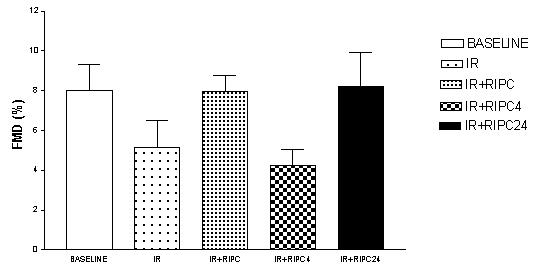| pA2 online © Copyright 2004 The British Pharmacological Society |
030P
GKT, University of London Winter Meeting December 2003 |
|
Remote ischaemic
preconditioning provides early and late protection against endothelial
ischaemia-reperfusion injury in humans |
|
Ischaemia-reperfusion (IR) contributes to tissue injury caused by vascular occlusion, and may be complicated by endothelial dysfunction. IR injury is reduced by brief periods of ischaemia (ischaemic preconditioning; IPC). There are 2 temporally distinct forms of protection; one that occurs immediately and lasts approximately 2 hours (first window), followed 24 hours later by a second window lasting 48-72 hours. IPC also protects against IR injury of tissues remote from those undergoing preconditioning (remote ischaemic preconditioning; RIPC; Kharbanda et al 2002), and protects the endothelium from IR injury in humans. However, the time-course of the protection caused by RIPC has not been characterised in humans. We hypothesized that there are 2 windows of protection caused by RIPC in humans during experimental IR injury to the endothelium.
Vascular ultrasound was used to assess endothelial function in healthy volunteers by measuring dilatation of the brachial artery in response to increased blood flow during reactive hyperaemia (flow-mediated dilatation; FMD). Endothelial IR injury was induced by 20 min of upper limb ischaemia (inflation of a blood pressure cuff to 200 mm Hg) followed by reperfusion. RIPC was induced by three 5-min cycles of ischaemia of the contralateral arm. On 3 separate occasions, the RIPC stimulus was applied immediately, 4 hr and 24 hr before IR. FMD was determined before IR and after 20 min of reperfusion (with or without RIPC). FMD (percentage change from baseline diameter) was expressed as mean±SEM and compared statistically by Students t test.
IR alone reduced FMD after 20 min of reperfusion (8.0±1.3% pre- versus 5.2±1.4% post-IR, n=10, P<0.005). RIPC prevented this reduction immediately (9.1±1.3% pre- versus 8.0±0.8% post-IR, n=10, P=0.37), protection was lost at 4 hr (FMD 8.4±1.6% pre- versus 4.3±0.8% post-IR, n=7; P<0.05), but returned 24 hr after the preconditioning stimulus (FMD 7.2±1.5% pre- versus 8.1±1.8% post-IR, n= 10, P=0.25).

These data indicate, for the first time in humans, that there are 2 phases of protection from IR injury by RIPC; an early phase within 4 hr, and a delayed, but equally effective phase after 24 hr. RIPC of the limb may protect vital tissues from clinical IR injury. These findings may enable optimal design of studies of the therapeutic effect of RIPC.
Kharbanda RK, Mortensen UM, White PA, et al. Transient limb ischaemia induces remote ischaemic preconditioning in vivo. Circulation. 2002; 106: 2881-2883.